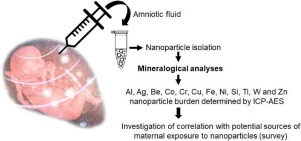Journal of Trace Elements in Medicine and Biology ( IF 3.6 ) Pub Date : 2020-02-27 , DOI: 10.1016/j.jtemb.2020.126477 Tiphaine Raia-Barjat , Carole Prieux , Lara Leclerc , Gwendoline Sarry , Lucile Grimal , Céline Chauleur , Jérémie Pourchez , Valérie Forest

|
Background
The impact of nanoparticles we are increasingly exposed to remains largely unknown. Of particular concern is the exposure of pregnant women and potential impact on fetal development. Indeed, many in vitro and in vivo animal studies have shown that nanoparticles are able to cross the placental barrier and induce toxic effects to the fetus. However, little is known in humans.
Objective
The aim and originality of this study were to investigate the nanoparticle burden of amniotic fluids in pregnant women. Methods - To that purpose, 100 amniotic fluids collected for clinical purposes were used to determine the nanoparticle quantity and nature by inductively coupled plasma atomic emission spectroscopy (NAMIOTIC, ClinicalTrials.gov Identifier: NCT02720887). Results - The prevalence of patients with a substantial concentration for the essential trace elements Cu, Fe and Zn was high, while that of patients with a substantial concentration of Al, Ag, Be, Co, Cr, Ni, Si, Ti and W was relatively low (under 20%). It was generally higher in the fraction containing nanoparticles and ions than in the fraction containing micro- and submicroparticles. No correlation was found between the nanoparticle burden and the different potential sources of exposure to nanoparticles (smoking status of the patient, living area, heating source, mode of transport, leisure, use of hygiene products and cosmetics and occupational activities).
Conclusion
Our results showing low concentrations and low prevalence of most of the assessed elements in amniotic fluids are reassuring. Further research is needed to draw firm conclusions on the developmental toxicity of engineered nanoparticles in humans but the present paper can provide a useful basis for further evaluation of the fetal toxicity of nanoparticles.
中文翻译:

人羊水的基本指纹图谱及其与孕妇暴露的潜在来源的关系
背景
我们日益暴露于纳米颗粒的影响仍然未知。特别令人关注的是孕妇的暴露及其对胎儿发育的潜在影响。确实,许多体外和体内动物研究表明,纳米颗粒能够穿越胎盘屏障并对胎儿产生毒性作用。但是,人类知之甚少。
目的
这项研究的目的和独创性是调查孕妇羊水的纳米颗粒负担。方法-为此,通过电感耦合等离子体原子发射光谱法(NAMIOTIC,ClinicalTrials.gov标识符:NCT02720887),使用了100种用于临床目的的羊水来确定纳米粒子的数量和性质。结果-高浓度的必需微量元素Cu,Fe和Zn的患病率较高,而Al,Ag,Be,Co,Cr,Ni,Si,Ti和W的高浓度患病率较高低(低于20%)。通常在包含纳米颗粒和离子的部分中比在包含微粒和亚微粒的部分中更高。在纳米颗粒的负担与暴露于纳米颗粒的不同潜在来源(患者的吸烟状况,生活区域,加热源,运输方式,休闲方式,卫生产品和化妆品的使用以及职业活动)之间未发现相关性。
结论
我们的结果表明,羊水中大多数评估元素的低浓度和低患病率令人放心。需要进行进一步的研究以得出关于工程纳米粒子对人类发育毒性的确切结论,但本论文可以为进一步评估纳米粒子的胎儿毒性提供有用的基础。











































 京公网安备 11010802027423号
京公网安备 11010802027423号